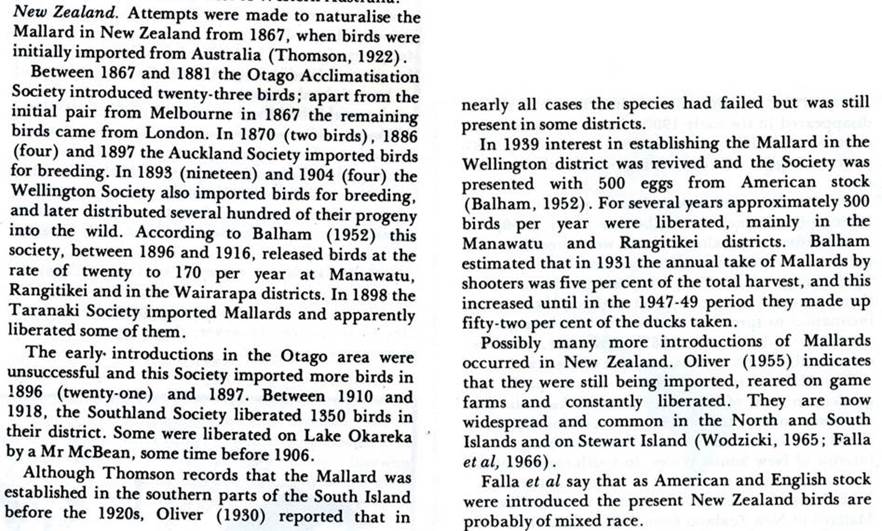John. My point relates to the uncertainty that the domestic varieties I have mentioned could breed with wild birds here. It would be good to be able to take
that further. However NZ is not a good parallel. What happened there was a quite different process. See below summary from Long,
Introduced Birds of the World. Deliberate liberation of wild strains in large numbers.

From: John Harris
Sent: Saturday, 12 May 2018 10:18 AM
To:
Subject: Re: [canberrabirds] Re: Information & ID of a Duck?
This conclusion surprises me a little, although I freely admit my lack of expertise. I don’t see why an domestic duck, if cohabiting with the PBDs, wouldn’t eventually
mate with one. Isn’t new Zealand a perfect example of mallards mating with PBD (‘Grey’) Ducks and their mallard genes infiltrating the whole PBD gene pool? I am very happy to be made better informed on this!
Thanks Alison. I’m guessing you had trouble getting that to the chatline for size reasons. Good point and worth resending with
one less pic I think.
As I understand it, nearly all domestic ducks, the Muscovy being an exception but including Indian Runner and Khaki Campbell and Rouen Duck varieties, are descended
from wild Mallard stock. In theory a white (non-Muscovy) ‘table duck (or drake)’ could mate with a Pacific Black Duck, but that seems unlikely to me somehow. Do we have any confirmed example? That could mean that all or nearly all the exotic ducks we are
seeing are inbred domestic varieties and reproductively harmless to the wild PBD pool. But who could be certain?
You are probably aware that there have been Mallards and what look like various cross-breeds on Lake Ginninderra for several years. While I haven’t seen any
ducklings (not visiting often in Summer in past years), there does seem to be an increasing number of cross-bred birds with different colourings over the past few years.
Photos from 2008 and 2016 show the different colourations over the years.
Thanks Christine. Useful information. I wouldn’t be surprised by local breeding within a ‘hybrid group’, which you confirm. I wonder if pure P Black Ducks
are being recruited into the pool, either as male or female. One clue is leg colour – female mallards and some hybrids will have orange/yellow legs. PBD leg colour more dull greenish rather like that right hand hybrid. Watch for shovelers, though. g
From: Christine [m("gmail.com","christine.d9933");">]
Sent: Friday, 11 May 2018 12:10 PM
To: COG chatline
Subject: Re: [canberrabirds] Re: Information & ID of a Duck?
If Geoffrey is right about it being the one from West Belconnen Pond (which I think quite likely), then this was a duckling from last
summer, and I have some very very poor photos from 2nd Jan 2017, The mother was a Mallard type, probably a hybrid, and the other duck in your photos is probably one of its siblings, as the ducklings were very close for over a year, and seen together (as in
Geoffrey's photo), just the 5 or 6 of them, usually a little apart from the other mallards.
A couple of years before there was a Mallard type female with 12 ducklings - 6 yellow and 6 brown, but I only saw them once as tiny ducklings,
so assume they all did not make it.
So yes, the domestic "Mallards" are breeding in the wild at WBP.
Message protected by MailGuard: e-mail anti-virus, anti-spam and content filtering.
http://www.mailguard.com.au/mg
Report this message as spam

